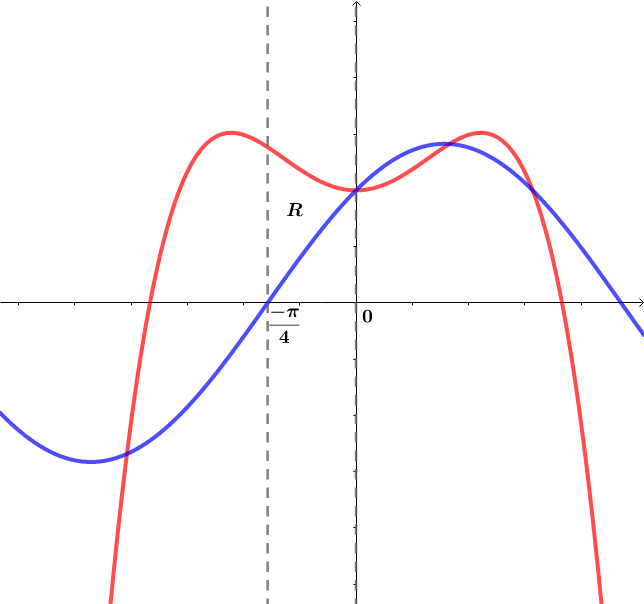Quartic functions and Trigonometric functions 2

Let f ( x ) = a x 4 + b x 2 + c and g ( x ) = sin ( x ) + cos ( x ) , where f ( 0 ) = g ( 0 ) , f ( 2 π ) = g ( 2 π ) and ∫ 0 2 π f ( x ) d x = ∫ 0 2 π g ( x ) d x .
If the area A of the region bounded between by the curves f ( x ) and g ( x ) on [ − 4 π , 0 ] can be expressed as A = β λ α β + β α γ λ π − β , where α , β , λ and γ are coprime positive integers, find α + β + λ + γ .
The answer is 17.
This section requires Javascript.
You are seeing this because something didn't load right. We suggest you, (a) try
refreshing the page, (b) enabling javascript if it is disabled on your browser and,
finally, (c)
loading the
non-javascript version of this page
. We're sorry about the hassle.
f ( 0 ) = g ( 0 ) = 1 ⟹ c = 1 and f ( 2 π ) = g ( 2 π ) = 1 ⟹ π 4 a + 4 π 2 b = 0 and ∫ 0 2 π g ( x ) d x = ∫ 0 2 π sin ( x ) + cos ( x ) d x = sin ( x ) − cos ( x ) ∣ 0 2 π = 2 ⟹
2 = ∫ 0 2 π ( a x 4 + b x 2 + 1 ) d x = 5 a x 5 + 3 b x 3 + x ∣ 0 2 π = 5 ∗ 2 5 π 5 a + 3 ∗ 2 3 π 3 + 2 π ⟹
3 π 5 a + 2 0 π 3 b = 9 6 0 − 2 4 0 π
π 4 a + 4 π 2 b = 0
Solving the above system we obtain:
a = 1 2 0 ( π 5 π − 4 ) and b = 3 0 ( π 3 4 − π ) ⟹
∫ 4 − π 0 f ( x ) d x = ∫ 4 − π 0 ( 1 2 0 ( π 5 π − 4 ) x 4 + 3 0 ( π 3 4 − π ) x 2 + 1 ) d x = 2 4 ( π 5 π − 4 ) x 5 + 1 0 ( π 3 4 − π ) x 3 + x ∣ 4 − π 0 =
4 4 6 ( π − 4 ) + 4 3 1 0 ( 4 − π ) + 4 π = 2 5 6 6 ( π − 4 ) + 4 0 ( 4 − π ) + 6 4 π = 2 5 6 3 0 π + 1 3 6 = 1 2 8 1 5 π + 6 8
and,
∫ 4 − π 0 g ( x ) d x = ∫ 4 − π 0 sin ( x ) + cos ( x ) d x = sin ( x ) − cos ( x ) ∣ 4 − π 0 = 2 − 1
⟹ ∫ 4 − π 0 f ( x ) − g ( x ) d x = 1 2 8 1 5 π + 6 8 − ( 2 − 1 ) = 1 2 8 1 9 6 + 1 2 8 1 5 π − 2 = 3 2 4 9 + 1 2 8 1 5 π − 2 = 2 5 7 2 + 2 7 3 ∗ 5 π − 2 = β λ α β + β α γ ∗ λ π − β ⟹ α + β + λ + γ = 1 7 .